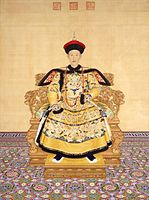
Photo from wikipedia
Objective To observe the clinical efficacy of lung-clearing and spleen-strengthening tuina on exogenous cough in children. Methods A total of 77 children with exogenous cough that met the inclusion criteria… Click to show full abstract
Objective To observe the clinical efficacy of lung-clearing and spleen-strengthening tuina on exogenous cough in children. Methods A total of 77 children with exogenous cough that met the inclusion criteria were randomly divided into a treatment group and a control group according to the random number table, with 39 cases in the treatment group and 38 cases in the control group. The routine lung-clearing manipulation was used in the two groups, while the spleen-strengthening manipulation was added in the treatment group. Both groups were treated once a day, 5 times as a course of treatment. After one course of treatment, the symptom score and clinical efficacy were observed. Results There were one dropout in the treatment group and 2 dropouts in the control group. Therefore, a total of 74 cases were finally included in the analysis, with 38 cases in the treatment group and 36 cases in the control group. After treatment, there was a statistically significant difference in cough score between the two groups ( P <0.05). There was a statistically significant difference in the score of poor appetite between the two groups ( P <0.05). After treatment, the total effective rate was 89.5% in the treatment group versus 75.0% in the control group, showing a statistically significant difference ( P <0.05). Conclusion The therapeutic efficacy of lung-clearing spleen-strengthening manipulation is better than that of lung-clearing tuina manipulation alone for children with exogenous cough; regulating spleen and stomach can improve the curative efficacy of exogenous cough in children. 目的 观察清肺健脾推拿手法治疗小儿外感咳嗽的临床疗效. 方法 将符合纳入标准的77例外感咳嗽患儿根据随机数字表分为治疗组和对照组, 治疗组39例, 对照组38例. 两组均采用常规清肺推拿手法, 治疗组在常规清肺推拿手法基础上辅以健脾推拿手法. 两组均每日治疗1次, 5次为1个疗程, 疗程结束后观察症状积分和临床疗效. 结果 研究过程中, 治疗组脱落1例, 对照组脱落2例, 最后纳入统计共74例, 即治疗组38例, 对照组36例. 治疗后两组咳嗽症状评分组间比较差异有统计学意义( P <0.05); 两组食欲不振评分组间比较差异有统计学意义 ( P <0.05). 治疗后, 治疗组总有效率为89.5%, 对照组总有效率为75.0%, 差异有统计学意义( P <0.05). 结论 清肺健脾推拿手法治疗小儿外感咳嗽的临床疗效优于单独清肺推拿手法; 重视调理脾胃可有效提高小儿外感咳嗽的治疗疗效.
Journal Title: Journal of Acupuncture and Tuina Science
Year Published: 2020
Link to full text (if available)
Share on Social Media: Sign Up to like & get
recommendations!